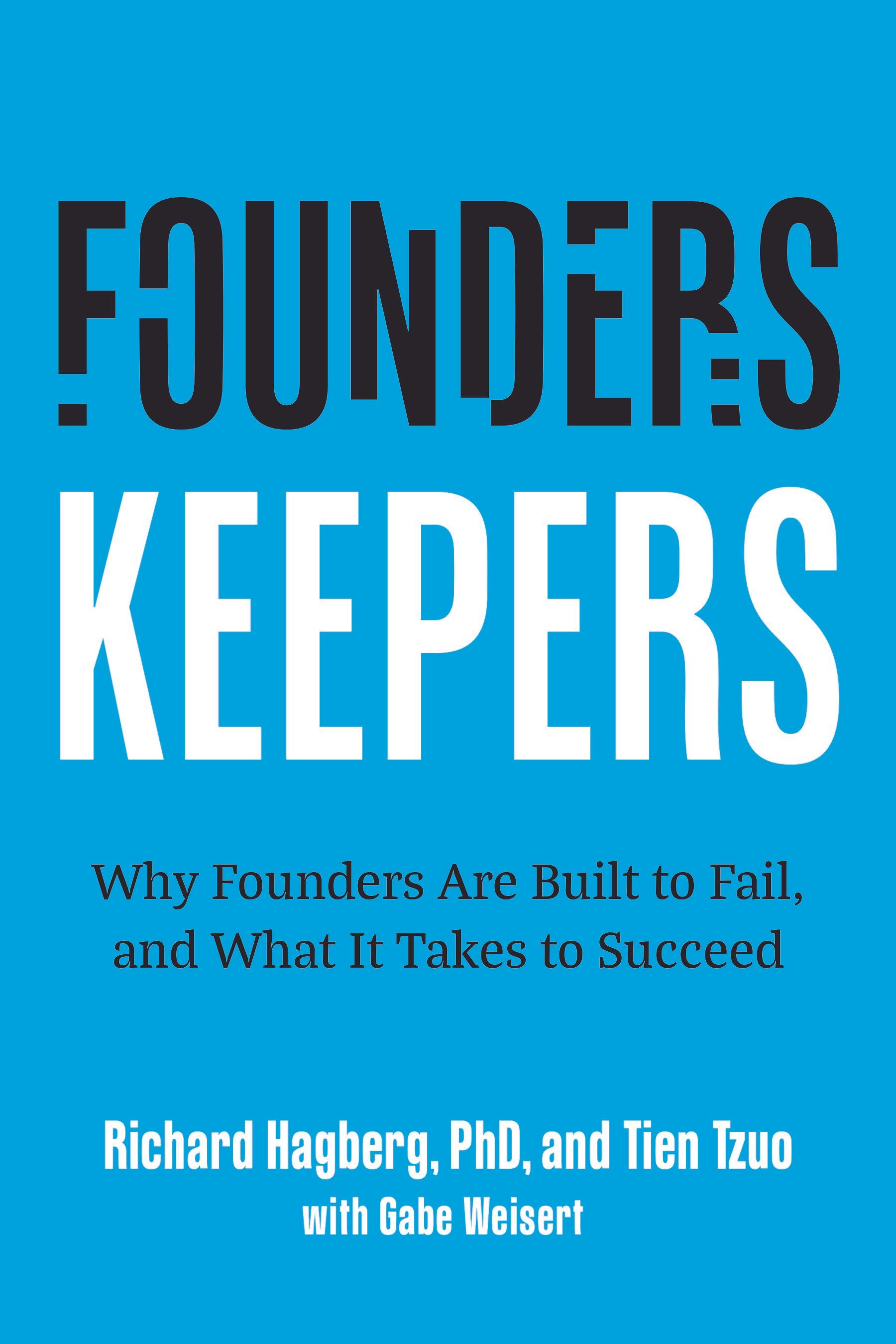Insights and Strategies
from Dr. Richard Hagberg's New Book:
Founders Keepers:
Why Founders Are Built to Fail
and What it Takes to Succeed.

The Curse of “High Standards” Let’s start with a truth that makes a lot of smart leaders squirm: perfectionism isn’t about excellence — it’s about fear. It starts innocently enough. You want things done right. You have taste. You notice what other people miss. People even praise you for it. But slowly, “high standards” turn into a straitjacket. You can’t hit send until the slide looks perfect. You can’t let someone else finish because “they won’t do it the right way.” You stay up tweaking a comma that doesn’t need tweaking. You call it quality. Everyone else calls it exhausting. Why Perfection Feels Safe Perfectionism isn’t driven by pride. It’s driven by anxiety. It’s the voice that says, “If I can control every detail, nothing bad can happen.” It’s fear of judgment dressed up as professional excellence. The irony is that perfectionists are often the most self-critical people in the room — constantly measuring themselves against an invisible, impossible ruler. They don’t chase perfection because they love quality. They chase it because they hate shame. The Productivity Mirage Perfectionism pretends to be productivity, but it’s actually procrastination with better branding. You tell yourself you’re “improving” the work when you’re really just postponing the moment you might get judged. Every hour you spend obsessing over polish is an hour you could’ve spent creating, delegating, or resting — three things perfectionists are famously terrible at. A Founder’s Wake-Up Call A founder I coached — let’s call him Ryan — was a world-class tinkerer. Every deck, every marketing campaign, every internal email went through him. He’d send back feedback like, “Good, but let’s tighten the phrasing on slide 12.” When his team started missing deadlines, he blamed their “lack of attention to detail.” In truth, they were stuck waiting for his endless revisions. When he finally took a week off, something shocking happened: everything got done. On time. He told me later, “Apparently, I was the bottleneck disguised as quality control.” Exactly. The Neuroscience of “Just One More Edit” Perfectionism lights up the same reward circuits in the brain as addiction. Every time you fix something, you get a tiny hit of relief — like a smoker taking a drag. That’s why you can’t stop. But the more you chase that relief, the narrower your focus becomes. You stop seeing the system. You start obsessing over the pixel. Leadership requires altitude. Perfectionism keeps you at ground level, rearranging the furniture while the building burns. The Lie of the Last 5% You know that feeling when something’s 95% done and you tell yourself, “Just one more pass.” That’s the lie. That final 5% rarely changes the outcome — it just delays it. You’re trading momentum for a false sense of control. I tell my clients, “Your 80% is probably everyone else’s 120%.” Ship it. Learn. Iterate. That’s how progress actually happens. How to Break the Cycle Redefine success. Replace “perfect” with “useful.” Ask, “Will this version move the needle?” If yes, it’s done. Set a timer. Give yourself a fixed window to refine something, then stop — no matter how it feels. Delegate imperfection on purpose. Hand off something messy and resist the urge to “fix” it afterward. That’s your real growth work. Publish before you’re ready. Whether it’s a proposal or a strategy draft, send it early. Feedback beats polish every time. Celebrate iteration. Reward teams for improving quickly, not for getting it “perfect” the first time. Funny but True I once worked with a VP who spent six hours choosing fonts for a quarterly report. When I asked him why, he said, “Details matter.” I said, “To who?” He blinked. Then laughed. “Probably just me.” That’s the moment perfectionism usually breaks — when you realize no one else cares about the thing stealing your sanity. What’s Really at Stake Perfectionism doesn’t just waste time. It kills creativity, trust, and joy. Your team stops taking initiative because they know you’ll re-do their work anyway. You become the bottleneck everyone avoids. And you start confusing fatigue with dedication. Excellence inspires. Perfectionism suffocates. The Emotional Shift: From Control to Curiosity Progress requires permission to experiment — to be wrong. When you trade “perfect” for “better,” you re-open the door to learning. And that’s where real innovation lives. Great leaders don’t aim for flawless execution. They build systems that learn faster than their competitors. That’s progress. Your Challenge This Week Take something you’ve been over-polishing — a presentation, a product feature, an email draft. Send it at 80%. Breathe through the discomfort. When your team improves it, resist saying, “See? I would’ve done that.” Instead, say, “That’s better than I imagined.” Because it is. Final Word Perfection feels like power. But real power is progress — messy, iterative, unfinished progress. Leadership isn’t about getting everything right. It’s about getting the right things moving. So send the draft. Launch the feature. Let good enough be great — and watch your world expand.

The Charisma Illusion Charisma gets all the press. It fills conference rooms, wins funding rounds, and dominates the LinkedIn highlight reel. We treat it like the gold standard of leadership — as if volume equals vision. But charisma is a sugar high. It spikes energy, then crashes trust. Composure, on the other hand — quiet, grounded, centered composure — is the kind of influence that lasts. It doesn’t light up a room; it settles one. When things go sideways, it’s not the charismatic leader people look for. It’s the calm one. The Crisis Test Picture this. The product just failed. The client’s furious. Your team’s pacing like trapped cats. Two leaders walk in. One storms into action — loud, fast, “What the hell happened here?” The other walks in slowly, looks around, and says, “Okay, let’s breathe. What do we know so far?” The first one gets attention. The second one gets results. That’s emotional geometry — the calmest person in the room reshapes everyone else’s state. Why Calm Is the Real Power When you stay composed, you’re not just managing your emotions — you’re regulating the entire system. Here’s the neuroscience behind it: people mirror the nervous system of whoever has the most authority. If you’re grounded, they sync to your rhythm. If you’re frantic, they sync to that instead. You don’t need to lecture anyone on resilience. You just have to model it. It’s not charisma that makes people trust you; it’s the quiet sense that you’re not going to lose your mind when things get hard. Charisma’s Half-Life Charisma is a spark. It can ignite a team — but if there’s no composure beneath it, the whole thing burns out. You’ve seen this movie before: the leader who rallies everyone with a passionate all-hands speech, then disappears into reaction mode when things get messy. Charisma without composure is like caffeine without sleep. You’re awake, but you’re not steady. Composure doesn’t get the applause. It gets the loyalty. A Founder’s Story One founder I worked with — I’ll call him David — was known for being a “high-voltage” guy. He could pitch an investor, fire up a crowd, or talk anyone into anything. But his team? They were walking on eggshells. His energy filled every room, but it left no oxygen for anyone else. During one session, I asked, “When you raise your voice, what happens to theirs?” He went quiet. That was the moment he understood that his passion — the thing he was most proud of — had become the team’s anxiety. A year later, his team described him differently: “He’s still intense, but steady. We trust him more now.” He didn’t lose charisma; he layered it with composure. The Calm Before the Influence Here’s what composure actually looks like: You listen longer. Because real influence starts with attention, not argument. You breathe before reacting. That pause isn’t weakness; it’s power management. You let silence do the work. Charisma fills every space; composure creates space for others to step in. You own your tone. You realize your sighs, your speed, your face — they’re all communication tools whether you intend them or not. You choose steadiness over certainty. People don’t need you to know everything. They just need to know you’re okay not knowing. Funny But True A client once told me, “When I’m calm in a meeting, people assume I’m hiding something.” I said, “Good. Let them wonder.” That’s how unfamiliar calm has become. In some cultures, composure looks radical — even suspicious. But it’s exactly what people crave in a world that never shuts up. Why Charisma Is Easier (and More Addictive) Charisma gets feedback. You see the energy rise, you feel the applause. It’s visible. Composure feels invisible — until you lose it. No one thanks you for staying calm during a crisis. But they remember it when deciding whether to follow you into the next one. That’s why maturity in leadership means getting comfortable with the quiet wins — the meeting that didn’t spiral, the argument that didn’t happen, the team that stayed focused because you did. The Emotional Geometry in Practice Think of composure as geometry because emotions move through space. When you enter a room, you alter its emotional shape. If you radiate calm, people’s shoulders drop. Their thinking widens. They start contributing. If you radiate stress, the room contracts. People shrink. Ideas vanish. Influence isn’t what you say. It’s the energy field you create. Your Challenge This Week Before your next high-stakes meeting, pause outside the door. Take one deep breath and ask yourself: What energy does this room need from me right now? Then bring only that. Nothing more. You’ll be amazed how fast everything slows down when you do. Final Word Charisma captures attention. Composure builds trust. One is about how loudly you shine; the other is about how steadily you glow. The leader who can stay centered when everyone else is spinning doesn’t just have influence — they are the influence. And that’s the kind of power that never burns out.

The Badge of Busyness If there were an Olympic event for back-to-back meetings, most executives I know would medal. They wear it proudly — the calendar that looks like a Tetris board, the 11:30 p.m. emails, the constant refrain of “crazy week.” Busyness has become our favorite drug. It keeps us numb, important, and conveniently distracted from the one question we don’t want to face: What am I actually doing that matters? I’m not judging; I’ve lived this. Years ago, I was “that guy” — sprinting through 14-hour days while telling myself reflection was for monks or consultants between clients. Then one day, after a particularly pointless meeting, I realized something embarrassing: I couldn’t remember the last time I’d had a single original thought. Why Thinking Feels Unproductive Here’s the irony: most leaders know they need to think more. They just can’t stand how useless it feels. Sitting in silence doesn’t produce slides or metrics. There’s no dopamine hit, no “good meeting” to log. But thinking time is like compound interest. It looks small in the moment and enormous over time. When you actually stop, patterns appear. You notice which fires you keep putting out, which meetings could’ve been emails, and which goals you’re chasing that don’t even belong to you anymore. A Simple Truth Busyness is a form of self-defense. If you never stop moving, you never have to confront the uncomfortable truths that surface when you do. That’s why reflection feels awkward at first — it threatens your illusion of momentum. But momentum without direction is just noise. A Founder’s Story One founder I coached had the classic startup badge of honor: chaos. His day started at 5:30 a.m., ended around midnight, and he bragged about being “in the weeds” with every decision. I asked, “When do you think?” He said, “All the time.” I said, “No — I mean deliberately.” He stared at me like I’d asked if he did yoga with dolphins. We scheduled two hours of thinking time a week. The first few sessions drove him nuts. He kept checking email, pacing, making lists. Then, around week four, he sent a note: “I finally realized half my problems were the result of not thinking before saying yes.” That’s the power of reflection — it turns self-inflicted chaos into clarity. The Science Behind Stillness Here’s the biology of it: when you’re rushing, your brain lives in survival mode — flooded with cortisol, locked on what’s urgent. When you slow down, another network kicks in — the one responsible for creativity, empathy, and pattern recognition. That’s why your best ideas show up in the shower or on long drives. The brain finally has enough quiet to connect dots. You don’t need more input. You need more oxygen. Why Leaders Avoid It Two reasons. It’s vulnerable. Reflection forces you to notice things you’ve been ignoring — the conversation you keep postponing, the hire you know isn’t working, the ambition that’s turned into exhaustion. It’s inefficient… at first. There’s no immediate ROI. But over time, reflection prevents the expensive rework that comes from impulsive decisions. As one client told me, “I used to say I didn’t have time to think. Turns out, not thinking was costing me time.” How to Reclaim Thinking Time (Without Quitting Your Job) Schedule “white space” like a meeting. Literally block it on the calendar. Call it “Strategy,” “Clarity,” or even “Meeting with Myself” if you’re worried someone will book over it. Change environments. Go walk, drive, sit somewhere with natural light. Different settings unlock different neural pathways. Ask bigger questions. Instead of “What needs to get done?” ask “What actually matters now?” or “What am I pretending not to know?” Capture patterns, not notes. Don’t transcribe thoughts — notice themes. What keeps repeating? That’s your mind begging for attention. End reflection with one action. Otherwise, it turns into rumination. Decide one thing to start, stop, or say no to. The Humor in It I once told an overworked exec, “Block 90 minutes a week just to think.” He said, “What should I do during that time?” That’s the problem in one sentence. Thinking is doing — it’s just quieter. What Happens When You Build the Habit At first, reflection feels indulgent. Then it feels useful. Then it becomes addictive — in a good way. Your decisions get cleaner. Your conversations sharper. Your stress lower. You stop reacting and start designing. Because clarity saves more time than hustle ever will. Your Challenge This Week Find one 60-minute window. No phone, no laptop, no music, no distractions. Just a notebook and a question: “What’s one thing I keep doing that no longer deserves my energy?” Don’t overthink it — just listen for what surfaces. That hour will tell you more about your leadership than a dozen status meetings ever could. Final Word In a world obsessed with movement, stillness is rebellion. But it’s also intelligence. The best leaders aren’t the busiest. They’re the ones who’ve learned that reflection isn’t retreat — it’s refinement. The next breakthrough won’t come from another meeting. It’ll come from the silence you’ve been avoiding.
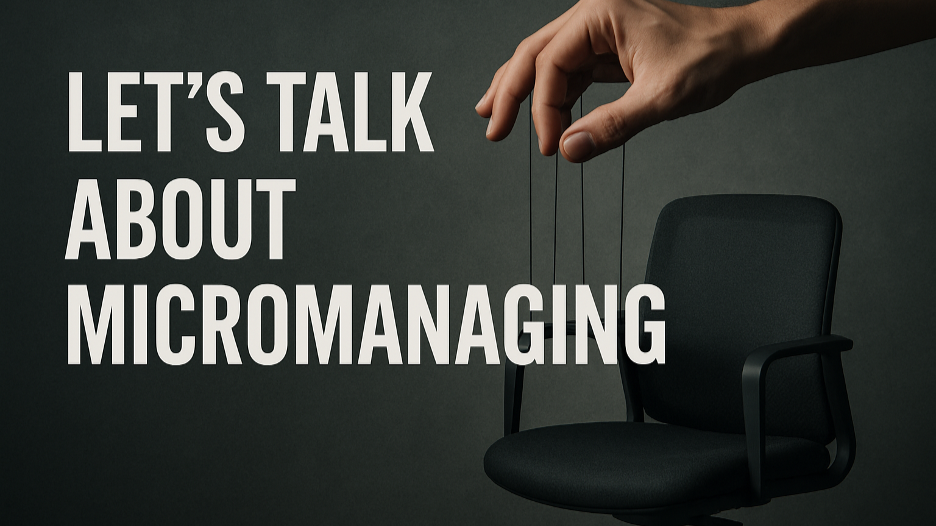
You’ve Met This Leader — Maybe You’ve Been This Leader They’re in every company. The one who rewrites your email “just to tighten it up,” sits in on meetings they don’t need to, and then complains that no one takes ownership. If you’re smiling, you probably recognize them. If you’re wincing, you probably are them. I’ve been that person. Control looks like competence until you realize it’s just fear in a tailored suit. Control Feels Smart — It’s Actually Emotional Self-Defense On the surface, micromanagement looks like high standards. Underneath, it’s self-protection. When things feel uncertain — a shaky market, an unpredictable teammate, a decision you’re not sure about — your brain hits the panic button: Grab the wheel. Fix it yourself. And for about five minutes, it works. You feel calm again. Order restored. Then the cycle restarts: relief, exhaustion, resentment. The pattern isn’t strategic; it’s chemical. The Biology of “Let Me Handle It” Neuroscientists could tell you it’s your amygdala firing, but you don’t need a lab to recognize it. It’s that pulse in your neck when someone questions you. The twitch in your fingers when you see an email thread veering off course. Your body thinks it’s protecting you from danger. It’s really protecting you from discomfort. The Fallout Nobody Talks About When leaders grip too tightly, a few predictable things happen: Initiative dies. People stop taking risks because they know you’ll redo their work. Speed tanks. Every decision bottlenecks at the top. Your best people leave quietly for air. You end up tired, irritable, and muttering that “no one has good judgment anymore.” That’s not leadership. That’s adult babysitting. Why We Keep Doing It Because control gives a quick hit of safety. For a brief moment, you feel indispensable again. But dependency feels like loyalty until it’s not. You train your team to need you, then resent them for it. That’s the hidden cost: you create the very helplessness you complain about. A Founder’s Wake-Up Call One founder I coached — let’s call him Mark — was in every meeting, approving every pixel, every sentence. He told me, “I can’t delegate; they’re not ready.” I said, “Are they not ready — or untrained because you won’t let them try?” He laughed, then sighed. Six months later he’d handed off half his decisions. The company was running smoother. He said, “Turns out they didn’t need me in every room. I just needed to feel needed.” Exactly. The Opposite of Control Isn’t Chaos It’s clarity. When expectations, priorities, and values are clear, you don’t need to hover. People move with confidence because the direction is obvious. Control fills the gap where clarity is missing. Get clearer, and the need to control starts dissolving on its own. Five Ways to Loosen the Grip Name the fear. Is it fear of failure, of being judged, of becoming irrelevant? Labeling shrinks it. Define “good enough.” Perfectionism keeps you chained. “Done” is usually 80 percent. Delegate one layer deeper than feels safe. You’ll twitch. Let it happen. That’s growth, not danger. Ask for alignment, not detail. “Are we still headed in the same direction?” beats “Show me the draft.” Celebrate the decisions you didn’t make. Each one is proof the system’s working. Your Team Feels What You Feel Teams mirror their leader’s nervous system. If yours hums with anxiety, theirs buzzes with it. If yours is steady, they breathe again. One exec told me, “I realized my panic was contagious. So I started practicing calm.” Within weeks, meetings got shorter, people more decisive. Emotions scale faster than strategy. Funny But True I once asked a CEO why he personally approved every expense report. He said, “To stay close to the details.” I said, “No — to stay close to control.” He laughed, deleted himself from the workflow, and called it his “first act of liberation.” The Inner Work Beneath Letting Go Control isn’t a systems problem. It’s a self-trust problem. When you trust that your worth isn’t tied to omnipresence, delegation stops feeling like loss. You stop needing to prove usefulness and start multiplying it through others. That’s the real transition from doer to leader. Your Challenge This Week Pick one thing you’ve been white-knuckling — a project, a client, a decision. Hand it off completely. Tell the person, “I trust you.” Then walk away. You’ll feel the urge to peek. Don’t. Let them carry it. Let yourself breathe. You’ll both grow faster than you think. Final Word Control looks like strength. But real strength is staying steady when you’re not in control. Because leadership isn’t about gripping tighter; it’s about building clarity, trust, and calm so others can steer too. Let go. The road’s wider than you think.
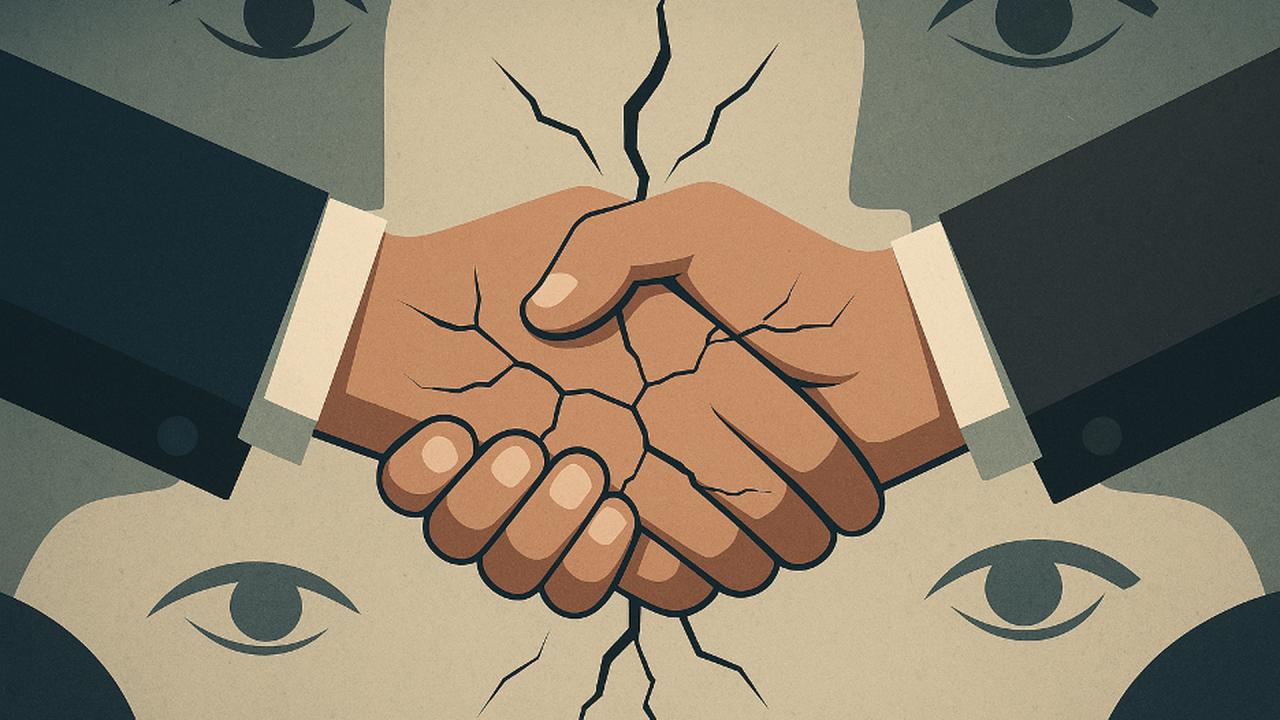
One of the biggest dilemmas that founders face knowing when and why to bring in a Chief Operating Officer (COO) . Too early, and you risk creating bureaucracy before the business finds its footing. Too late, and the founder becomes a bottleneck, throttling growth and burning out teams. Get the wrong type of COO, and you’ll spark culture clashes or stifle innovation. I have had 4 COOs over my career. Their styles and capabilities were very different and the role I needed them to play differed dramatically based on the stage of the company. Some of them worked out beautifully and were the perfect complement to my founder tendencies and limitations. Some were a disaster. Here is what I learned. The COO is the most variable role in the C-suite. Some founders never hire one. Others go through three or four before finding the right fit. In many cases, the question isn’t if you need a COO—it’s what type of COO your company and your leadership style demand at this stage of growth. Let’s break this down. Why COOs Matter Founders are visionaries. They are idea machines, market spotters, and force-of-nature storytellers who rally talent and investors around a dream. But those same strengths often come paired with weaknesses: disorganization, impatience, lack of systems, and difficulty letting go of control. A strong COO is the counterweight. They turn vision into execution. They stabilize culture. They keep promises made to customers and investors. And, at the right time, they free the founder to do what only the founder can do—set direction, evangelize the mission, and keep the spark alive. But “COO” isn’t one job. It’s a category. And picking the wrong type is like forcing a square peg into a round hole. The Seven Archetypes of COOs 1. The Executor The backbone of day-to-day operations. They build systems, enforce discipline, and make the trains run on time. Best fit: Visionary founders who thrive on ideas but leave chaos in their wake. Stage: Early scaling, when the business needs process without killing momentum. Examples: Sheryl Sandberg at Facebook (balancing Zuckerberg’s vision), Gwynne Shotwell at SpaceX (stabilizing Musk’s whirlwind). 2. The Change Agent The fixer. Brought in when transformation is urgent—scaling fast, restructuring, or pulling out of crisis. Best fit: Founders who know the business has outgrown their own operational grip. Stage: Scaling into hypergrowth, or turnaround scenarios. Examples: Daniel Alegre at Activision Blizzard, leading cultural and operational overhaul. 3. The Mentor/Partner The grown-up in the room. A seasoned leader who steadies a first-time or young founder, often more coach than operator. Best fit: Visionary but inexperienced founders, often in the earliest stages of institutional growth. Stage: Transition from startup scrappiness to formal organization. Examples: Eric Schmidt at Google—while not COO by title, he played this role for Page and Brin. 4. The Heir Apparent The COO as CEO-in-waiting. They take on broad P&L responsibility, often shadowing the founder before succession. Best fit: Companies preparing for leadership transition. Stage: Later scaling into maturit Examples: Tim Cook at Apple before succeeding Steve Jobs. 5. The MVP Functionalist The specialist. A COO with deep expertise in one critical area—finance, product, supply chain, or sales. Best fit: Founders strong in vision but weak in a single domain essential to scaling. Stage: Startup to early scale. Examples: Prabir Adarkar at DoorDash, covering finance and operations. 6. The Complement to the CEO’s Gaps A tailor-made role. If the founder is a disorganized visionary, the COO is structured and disciplined. If the founder is technical but introverted, the COO is outward-facing and people-savvy. Best fit: Any founder aware enough to know their own blind spots. Stage: Anywhere, but especially scaling. Examples: Sandberg balancing Zuckerberg’s lack of operational rigor; Shotwell countering Musk’s volatility. 7. The Integrator/Hybrid The most complex type. They unify strategy, execution, culture, and talent at once—bridging across multiple functions. Best fit: Complex, multi-line businesses with global teams. Stage: Scaling into maturity. Examples: Angela Ahrendts at Burberry, integrating brand, culture, and operations before moving to Apple. Why Founder–COO Relationships Fail So Often If the COO role is so valuable, why do so many founder–COO relationships crash and burn? Boards are often gun-shy about hiring COOs because they’ve seen these partnerships implode. The reasons fall into several predictable buckets. 1. Lack of Role Clarity The fastest way to sabotage the relationship is leaving the COO’s job undefined. Who owns what decisions? Where does accountability lie? If the COO’s role overlaps with the founder’s, or isn’t communicated to the rest of the team, the COO quickly becomes either a glorified project manager or a powerless deputy. Both end badly. 2. Founder’s Inability to Let Go Many founders simply can’t let go. They want to approve every detail, revisit every decision, and undermine the very autonomy they hired the COO to exercise. A COO who feels second-guessed or constantly overruled either disengages or quits. 3. Misaligned Vision and Values Operational excellence isn’t enough if the COO doesn’t fully buy into the founder’s vision and cultural values. When the COO wants to optimize for stability while the founder is pushing disruption—or vice versa—the two end up pulling the company in opposite directions. 4. Trust and Emotional Reactivity Trust is fragile. If the founder is volatile under stress, or the COO isn’t skilled at navigating the founder’s personality, the relationship becomes brittle. Outbursts, defensiveness, or miscommunications erode psychological safety between them and ripple across the organization. 5. Succession Ambiguity and Power Tensions Is the COO being groomed as the future CEO—or not? Few questions create more tension. If expectations aren’t clarified up front, the COO may feel misled and the founder may feel threatened. Meanwhile, employees begin to compare the two and pick sides. Boards have seen this movie before, and it rarely ends well. 6. Unrealistic Expectations Founders and boards often expect the COO to “fix everything yesterday.” In reality, operational improvements take time—learning systems, culture, and people. When results don’t appear overnight, frustration builds. On the flip side, some COOs expect to make sweeping changes immediately, without respecting the founder’s legacy or the team’s tolerance for disruption. 7. Culture and Communication Breakdowns The founder and COO need structured ways to align—weekly check-ins, clear communication norms, and mechanisms to resolve disagreements. Without them, minor irritations accumulate into major grievances. Worse, the team sees open conflict at the top and begins to question who’s really in charge. 8. Identity and Ego Issues Let’s name the elephant in the room: many founders see hiring a COO as an admission of weakness. They sabotage the hire by bypassing the COO or contradicting them in front of the team. On the other side, ambitious COOs often chafe at being “Number Two.” If the relationship isn’t anchored in humility and respect, egos will clash. How Founders Can Prevent the Breakdown Knowing the pitfalls is only half the battle. Preventing them takes deliberate work: Define the COO’s mandate explicitly —what they own, what’s shared, and what stays with the CEO. Set up trust rituals early —regular one-on-one check-ins to surface tension before it festers. Align on vision and values —not just what you’re building, but how you’ll build it and why it matters. Clarify succession expectations —is this person a partner, a long-term No. 2, or a potential future CEO? Say it. Set realistic timelines —agree on milestones, but don’t expect magic overnight. Communicate clearly to the org —so employees understand who does what and aren’t caught in the crossfire. Hire for complementarity —choose a COO who fills your blind spots, not one who duplicates your strengths. The founder–COO relationship is like a marriage with the pressure of Wall Street, venture capital, and 200 employees watching. When it works, it’s transformative. When it doesn’t, it’s messy, public, and expensive. The Founder × Stage × COO Fit So how do you know when and which type of COO to bring in? Here’s the decision logic: Startup + Visionary Founder Needs an Executor or Mentor/Partner. Someone to turn chaos into motion without killing energy. Startup + Operator Founder May not need a COO yet. If they do, it’s usually a domain specialist (MVP Functionalist) to cover blind spots. Scaling + Visionary Founder Needs an Integrator or a Complement to gaps. Execution and people issues become bottlenecks. Scaling + Operator Founder May need a Change Agent or Heir Apparent. The role becomes about transformation or succession. Mature Company + Visionary CEO The COO role is succession-oriented (Heir Apparent) or complex integration (Hybrid). Mature Company + Operator CEO Sometimes no COO is needed; the CEO already runs operations. In other cases, the COO is simply the next CEO waiting in line. Takeaway Hiring a COO isn’t about “offloading work.” It’s about admitting what kind of company you’re really building, and what kind of leader you are. If you’re the spark but not the engine, you need an Executor. If you’re a force of change but leave wreckage behind, you need a Relationship-Builder complement. If you’re building for the long haul, sooner or later you need an Heir Apparent. The best founders aren’t the ones who try to do it all. They’re the ones who know when to step aside—just enough—to let someone else make the company stronger. Closing Thought In Founders Keepers, I often say: what got you here won’t get you there. The founder’s job is to create possibility. The COO’s job is to turn possibility into performance. The only real mistake is waiting until your company is already fraying before you decide which kind of COO you need. By then, the cost of waiting may be higher than you can afford.

The Founder’s Dilemma Founders are fountains of ideas. You see possibilities everywhere, you connect dots others can’t, and you can sell a vision with enough energy to light up a room. But there’s a problem: ideas don’t implement themselves. They need systems, people, and execution discipline. In my coaching of more than a hundred startup founders—and backed by data from 122 founder assessments—the same challenge comes up again and again: founders are world-class at generating ideas, but their companies stumble when those ideas aren’t translated into action. I have struggled with this tendency for my entire career. My creative ideas just keep bubbling up and my execution discipline and focus can’t keep up. I have the classic “shiny object” distraction problem shared by many founders. The irony? The very traits that made me a classic visionary evangelist—creativity, independence, impatience, and risk tolerance—are the same traits that made execution difficult. If you want your ideas to live beyond a brainstorming session, you must learn to do what feels unnatural: offload execution, delegate real authority, and empower others to carry your vision forward. Why Great Ideas Die Without Execution Most failed ideas don’t die because they weren’t brilliant. They die because: 1. The founder keeps ownership too long, trying to do everything personally instead of empowering others. 2. Delegation is fake, with tasks assigned but no real authority granted, leaving the founder still in control. 3. Priorities aren’t clear, so teams are overwhelmed by too many initiatives and unsure of what matters most. 4. Accountability is weak, with no consistent follow-up or consequences when commitments slip. 5. Founders love possibilities but resist discipline, avoiding the planning, sequencing, and focus execution requires. 6. Ideas are left open-ended, because founders generate endlessly but fail to converge on closure and completion. 7. Optimism turns unrealistic, as founders overestimate what’s possible and ignore what could go wrong. 8. Expectations aren’t communicated, leaving teams uncertain about roles, outcomes, and next steps. 9. They rush ahead without buy-in, moving too fast to bring others along and win their commitment. 10. They undervalue operators, failing to leverage managers of execution who can turn vision into systems. This is what I call the founder time bomb. Early success convinces you that your personal hustle is the engine of growth. But as the company scales, hustle becomes a bottleneck. Unless you shift, your best ideas will choke on lack of oxygen. Step 1: Translate Vision Into Tangible Priorities Your job as a founder isn’t to hand down a 37-slide vision deck and hope for the best. Your team needs clarity. That means breaking down your big idea into concrete, winnable battles. Set the “critical few” : Define 3–5 top priorities for the quarter. Outcome > activity : Don’t assign tasks, define the result (e.g., “Increase retention by 5%”). Overcommunicate : If you feel like you’re repeating yourself, you’re doing it right. One founder I coached changed his company trajectory by beginning every weekly meeting with just three priorities. The noise vanished. His team finally knew what mattered. Step 2: Practice Real Delegation, Not Fake Delegation Too many founders think delegation means assigning a task and then hovering over the person doing it. That’s not delegation—that’s micromanagement with extra steps. Real delegation means: Handing over ownership, not just chores. Giving the decision rights along with the responsibility. Accepting that “80% their way” may be better than “100% your way.” Here’s a phrase worth practicing: “You own this. You don’t need my approval.” Few sentences are harder for founders to say. Few sentences build more trust. Step 3: Build a Culture of Accountability Without Becoming a Tyrant Accountability is where many founders stumble. They either avoid conflict (hoping problems fix themselves) or they overreact when deadlines slip. Both extremes poison execution. Healthy accountability requires: Clear expectations : No hidden rules or shifting targets. Visible commitments : Public goals build peer pressure to deliver. Rhythms of review : Regular check-ins that aren’t nagging but structured. Consequences : Underperformance addressed quickly, not ignored. Accountability isn’t punishment—it’s support. It says, “I expect the best from you because I believe in you.” Step 4: Share Information Like Oxygen Execution thrives on information. Yet many founders hoard knowledge—sometimes out of habit, sometimes out of insecurity. Teams can’t execute if they don’t understand the why behind the what. Empowered teams need: Transparent dashboards : Everyone sees progress metrics. Context, not just orders : Explain reasoning, not just results. Accessible strategy docs : Kill the “founder black box.” When people understand the big picture, they stop running back to you for every decision. They start acting like owners. Step 5: Invest in Second-Line Leaders Scaling execution isn’t about having 50 great individual contributors—it’s about having 5 managers who can each lead 10 people effectively. Yet many founders neglect their managers, focusing instead on product or fundraising. Strong second-line leaders can: Translate your vision into plans. Coach their teams instead of doing the work themselves. Spot and develop talent below them. Your leverage point is not how many people you personally manage, but how many leaders you multiply. Step 6: Watch Out for Founder Autopilot Your instincts—boldness, independence, impatience—got you this far. But they can sabotage you at scale. I call this founder autopilot. It looks like: Jumping back into execution “just to speed things up.” Overloading the team with new initiatives before finishing the old ones. Cutting around your managers and making unilateral calls. The cure is self-awareness. Tools like 360 feedback and coaching help you notice when you’ve slipped back into heroic founder mode instead of scalable leader mode. Step 7: Celebrate Execution, Not Just Ideas Most founders glorify the spark of ideation but forget to recognize the grind of implementation. If you only celebrate creativity, you’ll get lots of brainstorming but little delivery. Shift the culture: Spotlight the team that launched, shipped, or solved—not just the one that dreamed. Tell stories of execution at all-hands meetings. Publicly recognize “builders,” not just “visionaries.” What you celebrate becomes what your team repeats. The Founder’s Evolution: From Genius to Builder of Builders The founder who can’t offload execution ends up as the bottleneck, exhausted and surrounded by frustrated employees. The founder who masters delegation and empowerment evolves into something much more powerful: a builder of builders. In my research, the difference between founders who scaled 10x and those who flatlined wasn’t idea quality. It was execution quality. The 10x founders learned to empower others, create accountability systems, and step back from doing everything themselves. The founder who shifts from “I’ll do it” to “I’ll ensure it gets done” makes the leap from fragile startup to durable company. Closing Thoughts Ideas ignite companies, but execution sustains them. If you want your vision to shape reality, you must resist the temptation to hold the reins too tightly. Translate vision into priorities. Delegate real authority. Build accountability and transparency. Develop leaders beneath you. And above all, celebrate execution as much as you celebrate ideation. That’s how founders ensure their ideas don’t die in the brainstorm stage but live on as products, services, and companies that change the world.
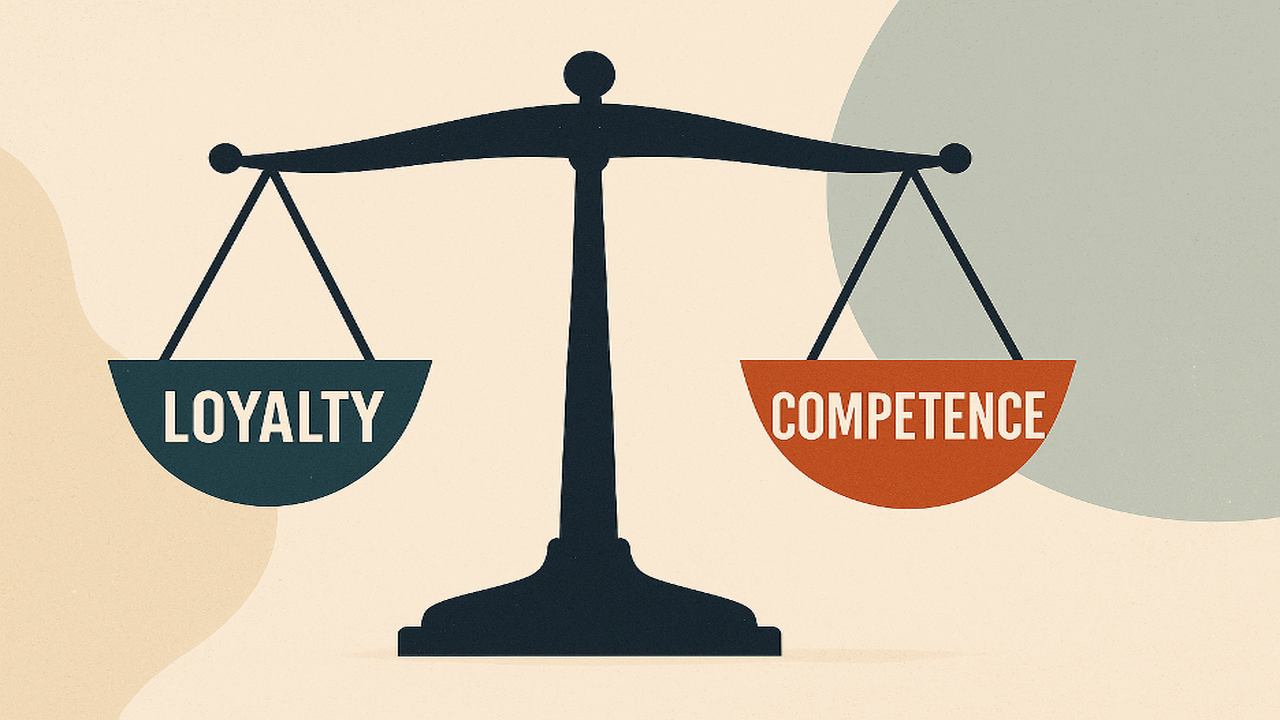
Every founder eventually faces a moment of reckoning. It doesn’t arrive with a clear announcement. It creeps in gradually, often disguised as small frustrations: projects slipping, team members complaining, or investors quietly losing confidence. And at the center of it all is a painful truth: The people who carried you through the chaos of the early days, the ones who slept on office couches, pulled all-nighters, and took pay cuts to bet on your dream—can no longer keep up. The company has grown. The stakes are higher. And the job has outgrown them. This is one of the hardest truths in entrepreneurship, and one most founders struggle to face. Instead of acting, they convince themselves: “She’ll grow into the role.” “He’s been with me since day one—I can’t let him go.” “Loyalty matters more than resumes.” But here’s the hard truth that separates founders who scale from those who stall: loyalty doesn’t scale. Competence does. The Startup Version of the Peter Principle The Peter Principle tells us that in large corporations, people rise to their level of incompetence. In startups, this principle plays out in hyper-speed. What made someone a hero in a five-person company, improvisation, raw hustle, and the willingness to do anything becomes a liability in a 50- or 500-person company. Think about the hacker who was indispensable in the garage. Brilliant at rapid problem-solving, he could patch servers at 3am and crank out features in a weekend. But leading a team of 50 engineers requires a totally different skill set: planning, delegation, recruiting, building processes. His improvisation becomes chaos. His genius turns into bottlenecks. Or the co-founder who thrived on energy and vision. In the early days, charisma and instinct were enough. But scaling requires a discipline around metrics, process, and accountability. What once looked like bold leadership now looks like reckless improvisation. Even the beloved “culture carrier”—the person who organized team offsites, boosted morale, and made the company feel like family—can become a roadblock. When decisions stack up and complexity explodes, loyalty and good vibes aren’t enough. What the company needs is a strategic operator, not just a glue person. This is what I call team obsolescence : the brutal, recurring reality that many early employees get outgrown by the job. The Head vs. Heart Conflict Why do founders struggle so much with this? It’s not because they’re blind. It’s because they’re human. The tension isn’t just intellectual—it’s emotional. Guilt and Indebtedness : Early employees bet on you before anyone else did. They turned down safer jobs, endured lower salaries, and staked their careers on your vision. Cutting them loose feels like betrayal. Psychologists call this the principle of reciprocity: the human drive to repay sacrifices. Founders feel they owe these people more than just a paycheck. Fear of Losing the Magic : Founders often worry that bringing in “outsiders” will ruin the scrappy, intimate culture that made the company special. This is a classic case of in-group bias. We trust the familiar, even when it’s no longer fit for purpose. Many founders cling to the idea that culture is fragile and must be protected from “corporate types.” Conflict Avoidance : Few people relish difficult conversations. Founders, especially those wired to inspire rather than confront, often procrastinate on hard personnel decisions. This is loss aversion at work: the immediate pain of conflict feels worse than the long-term risk of stagnation. Blind Loyalty Bias : Founders frequently overestimate an early employee’s ability to “grow into” a scaled role. This is the halo effect: past loyalty and past performance cast a glow that blinds you to current shortcomings. This is the founder’s head-versus-heart struggle. Rationally, you know the company has outgrown someone. Emotionally, you can’t let go. A Founder’s Story: When Friendship Meets Reality One founder I coached built his company with a close college friend. This friend was the first engineer, working nights and weekends to bring the product alive. He coded nonstop, patched outages at all hours, and was the reason the company survived its early chaos. By Series B, the company had 80 employees. Suddenly the role wasn’t about heroic coding; it was about systems, processes, and leading dozens of engineers. The founder knew his friend was drowning. Deadlines slipped. Senior engineers were frustrated. Investors raised eyebrows. But he kept saying, “He’s been with me since the beginning. I owe him.” Eventually, he faced reality. With coaching, he had the hard conversation: “You’re invaluable to this company, but the role has outgrown your strengths. Let’s find a place where you can thrive without being set up to fail.” The friend transitioned into a specialist role where his brilliance could shine without the weight of leadership. The company brought in a seasoned VP of Engineering. Painful as it was, the decision saved both the company and the friendship. This is the essence of true leadership: honoring loyalty without letting it sink the ship. The High Price of Avoidance The costs of avoidance aren’t abstract—they’re devastating. Execution Bottlenecks : An underqualified leader slows everything down. Projects drag, opportunities slip, and customers churn. It’s like trying to scale a skyscraper on a foundation built for a cottage. A-Players Walk : The best people won’t stay if forced to work under weak leaders. They leave, taking ambition and excellence with them. The company becomes a place where mediocrity thrives. Culture Corrodes : Protecting underperformers sends a loud signal: politics matter more than performance. Over time, resentment builds. High performers check out. Trust erodes. Investor Mistrust : Boards and investors notice quickly when execution falters. They start asking tough questions—not just about your team, but about your judgment as a founder. Founder Burnout : Perhaps the greatest cost: you, the founder, pick up the slack. Instead of scaling your vision, you spend nights fixing problems others should solve. Exhaustion sets in. Your energy, the one resource no one else can replace, gets depleted. What feels like an act of loyalty today can quietly strangle the company’s future. Another Case: The Culture Carrier I once worked with a founder whose operations manager was beloved by the team. She organized payroll, ordered office supplies, and planned offsites. She was the glue. But when the company hit 150 employees, the demands shifted. The job required scalable systems, compliance expertise, and strategic HR planning. She was still running things on spreadsheets and memory. People loved her, but they were increasingly frustrated with the chaos. The founder feared that replacing her would “destroy the culture.” Eventually, he hired a Head of People. But instead of cutting her out, he redeployed her into an employee experience role. She continued to be the cultural heartbeat of the company while freeing leadership to professionalize operations. The lesson: redeployment, when done thoughtfully, preserves loyalty without sacrificing competence. What Great Founders Do Differently The best founders I’ve studied don’t avoid this problem. They approach it with discipline and compassion. 1. They Diagnose Early They don’t wait until the crisis is obvious. They ask themselves, “If I were hiring for this role today, at this stage, would I choose this person?” If the answer is no, they don’t kick the can—they act. 2. They Separate Potential from Plateau Some people can grow. With coaching, training, and mentorship, they can rise to the next level. Others plateau quickly. Great founders don’t confuse the two. They invest in growth where it’s possible and cut losses where it’s not. 3. They Redeploy with Respect This isn’t about discarding people. The best founders move loyal employees into roles where their strengths shine—special projects, advisory positions, cultural leadership. Redeployment preserves respect and institutional knowledge while freeing the company to grow. 4. They Upgrade Before Crisis They don’t wait until the engine fails. They hire seasoned executives early, before execution falters. And they communicate clearly: every stage requires different skills. Honoring the past doesn’t mean guaranteeing the future. Leadership with Compassion The real test of a founder isn’t whether you can attract capital or inspire a team. It’s whether you can make the painful calls that protect the company’s future while respecting the people who got you started. True leadership is not about cold detachment. It’s about balancing head and heart: Gratitude means honoring contributions, celebrating sacrifices, and rewarding loyalty. Governance means making clear-eyed decisions about whether someone can perform at the next level. When founders confuse the two, they put sentiment ahead of survival. But when they balance both, they create companies that endure. One founder I know addresses this directly with his team: “Every stage requires new skills. Some of us will grow into them. Others will contribute in different ways. What matters is building a company that lasts.” That’s leadership with compassion—telling the truth while honoring the past. Why This Matters More Than Ever The startup environment today is more unforgiving than ever. Capital is tighter. Investors are quicker to act. The margin for error is smaller. In this climate, founders who delay tough calls are at greater risk than ever. Execution failures and cultural corrosion are spotted instantly by boards and competitors. The founders who scale are those who balance loyalty with realism—who act before the cracks widen into chasms. The Founder’s Real Test It’s easy to celebrate early wins and bask in loyalty. The real test is whether you can honor that loyalty without being trapped by it. Because here’s the paradox: The only way to truly honor early sacrifices is to build a company that endures. And that means making the call when loyalty becomes liability. Call to Action If you’re a founder facing this dilemma, don’t wait for the board to force your hand. Don’t wait for top talent to walk or investors to lose confidence. Confront it now. Diagnose honestly. Redeploy with respect. Upgrade before crisis. Be compassionate. Be decisive. Be clear-eyed. Your team—and your company—will thank you later.
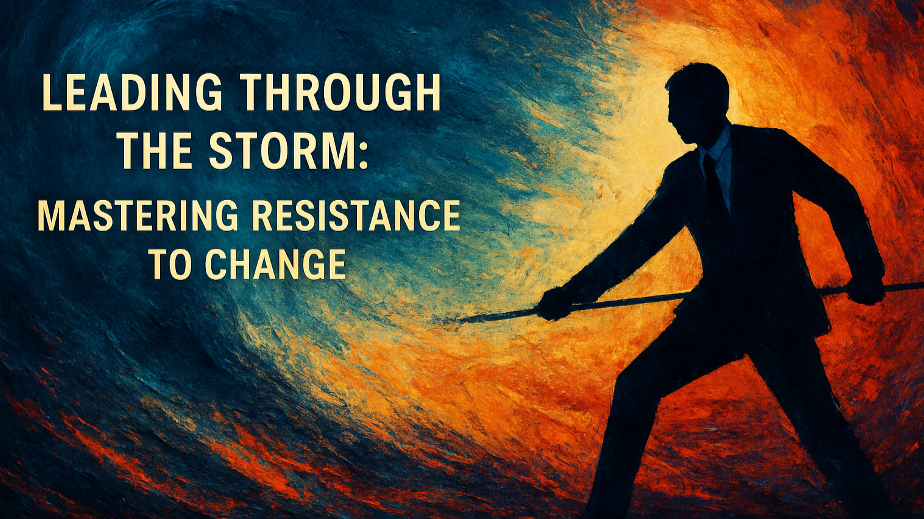
Introduction: The Brutal Truth About Change If you’re leading a company, here’s one brutal truth you can’t dodge: resistance to change isn’t just inevitable—it’s a gift. Most leaders don’t see it that way. They treat it like an obstacle to bulldoze, something to out-argue, out-maneuver, or silence. But resistance, if you know how to read it, is a living, breathing diagnostic tool. Every objection, every sideways comment in a hallway, every moment of awkward silence in a meeting—it’s all data. It tells you where the trust gaps are, where the communication breakdowns have happened, and where your people’s unspoken fears live. If you ignore that data, you’re flying blind. The hard numbers back this up: more than 70% of organizational change initiatives fail, not because the strategy was flawed, but because leaders underestimated what it would take to guide people through the emotional turbulence of transformation. If you want your next big initiative to succeed, the shift starts here: stop seeing resistance as the enemy, and start listening to what it’s telling you. When you do, you’ll discover that resistance isn’t a wall to break down—it’s a map showing you exactly where to go next. 1. Rethink Resistance: It’s Data, Not Defiance Let’s flip the lens. When people resist, they’re rarely doing it for sport. They’re sending up flares. They’re telling you something’s unclear, untested, or untrusted. For example, I worked with a CEO rolling out a sweeping technology overhaul. His first instinct when his managers hesitated was frustration—until we sat down and dissected the resistance. It turned out the managers weren’t doubting the technology; they were worried about the gap between the training timeline and the rollout date. They didn’t fear change—they feared being set up to fail. When you stop labeling resistance as “non-compliance” and start treating it like intelligence gathering, you find it points to the very levers you can pull to move the change forward.


